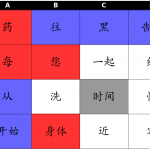Articles in the ‘Beginner’ category Page 19
-
Learning (or not learning) Chinese slang
Learning slang in Chinese can be fun, but it’s worth remembering that in most situations, it’s actually much less useful than more standard ways of expression. Slang is used in a limited context and changes quickly.
Read → -
Playing Codenames to learn Chinese and other languages
Codenames is one of my favourite games, and it also happens to be an excellent game for language learning! In this article, I suggest ways of playing it in Chines, along with a tool that generates grids of code words for direct use in the classroom or elsewhere!
Read → -
Comprehension-based listening vs deep end immersion
What works best for improving listening ability, graded content targeted at your specific level or deep-end immersion? The answer is that both approaches are necessary, but which you use depends a lot on practical considerations, as well as how much time and energy you have to invest.
Read → -
10 ways of using games to learn and teach Chinese
Games are great for learning languages. Here are ten ways you can use games to learn or teach Chinese as a second language!
Read → -
A student’s guide to comprehension-based learning
In this third and final article, the focus is on how students can make their own learning comprehension-based, with or without a teacher. It draws from the principles and ideas of the previous articles and allows you to apply these to your own learning.
Read → -
The benefits of a comprehension-based approach for teaching and learning Chinese
Diane Neubauer continues her series of guest articles about comprehension-based approaches to teaching and learning Chinese. In this the second part, the focus is on principles and motivations for using a comprehension-based method. There’s also an overview of teaching practices that fall into this category.
Read → -
An introduction to comprehension-based Chinese teaching and learning
This guest article by Diane Neubauer introduces comprehensible input and what it can do for us as language learners and teachers. It’s the first part of a series of three articles, focusing on comprehension-based methods for learning and teaching.
Read → -
How to fake sounding like a native Chinese speaker
Have you ever wanted your Mandarin to sound more advanced than it is? In this guest article, David Moser tells us how to fake sounding like a native Chinese speaker. While tongue-in-cheek, some of the advice applies even if you’re after the real thing!
Read → -
Spaced repetition is not limited to flashcards
Spaced repetition is important for learning anything, but especially vocabulary in a foreign language like Chinese. However, there’s much more to spaced repetition than vocabulary flashcard apps! Even if you dislike such apps, make sure you incorporate spaced repetition in some other way.
Read → -
Looking up how to use words in Chinese the right way
Looking up how to express something in Chinese is not as easy as it looks. Assuming that a word, especially a verb, can be used the same way in Chinese as in your native language usually results in incorrect or awkward sentences. Stop assuming and look things up properly instead!
Read →









